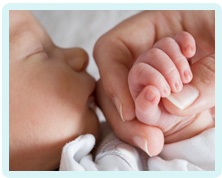
Perineum Tear
The perineum can tear during childbirth. A perineal tear is different to an episiotomy, which is done deliberately.
Perineal tear childbirth
Although the vaginal opening does expand during childbirth to allow the baby to be delivered, it may not be wide enough to accommodate the baby's head and shoulders.
Consequently the perineum – which is the tissue in between the vagina and anus – will be put under significant strain as the baby's head and shoulders press upon it. Again, the perineum is very elastic and will stretch during the birth. However, if the vaginal opening and perineum cannot expand far enough, the perineum will rip.
When the perineum rips during childbirth, the patient is said to have a perineal tear. There are different types of perineal tear which are classified according to the level of severity. Some women might experience a very small tear that just involves the skin. This is called a first degree tear. On the other hand, some will suffer a very deep tear that runs through the perineal muscle into the anal sphincter and rectum. This is called a fourth degree tear.
A perineal tear will need to be diagnosed and repaired shortly after the birth has finished. Third and fourth degree tears are more difficult to repair, which is why the injury must be sutured by a surgeon in theatre. First and second degree tears are less serious and can be stitched by a midwife in the delivery suite.
Episiotomy
A perineal tear is not the same thing as an episiotomy. An episiotomy is when the perineum is cut deliberately with a pair of sharp scissors. This is done if medical practitioners feel the vaginal opening needs to be expanded. Usually this will be necessary if forceps are going to be applied.
An episiotomy does not prevent a perineal tear. It was previously thought that episiotomies helped to avoid perineal tears, but this is no longer the case. Therefore a woman could need stitches for an episiotomy and a perineal tear.
Is there a case of medical negligence?
A perineal tear is a natural part of childbirth and will not amount to medical negligence. However, it is negligent to fail to diagnose and repair a perineal tear. This will result in a poor outcome and can cause life-changing symptoms such as faecal incontinence.
An episiotomy should only be carried out in the UK if there is a clinical need – such as to make room for forceps. Performing an unnecessary episiotomy can be negligent, as can using blunt scissors or making the cut straight downwards (it should be made diagonally).
Legal advice
To find out more about perineal tear medical negligence claims, please get in touch with us today.
Please call us on 0800 234 3300 (or from a mobile 01275 334030) or complete our Online Enquiry Form.



